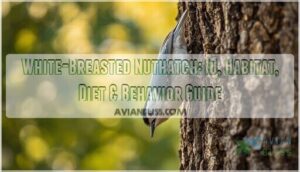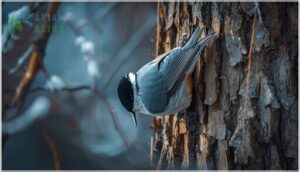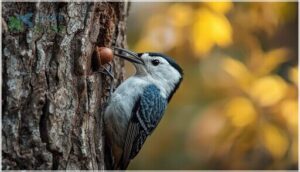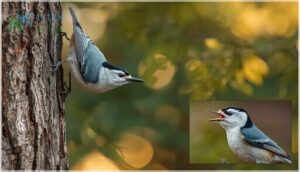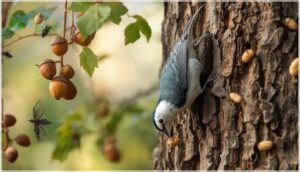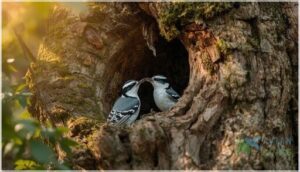This site is supported by our readers. We may earn a commission, at no cost to you, if you purchase through links.
You won’t find many birds that walk headfirst down tree trunks, but the white-breasted nuthatch does it without a second thought. This compact woodland acrobat defies gravity as naturally as most birds perch on a branch. Its distinctive black cap, white face, and blue-gray back make it one of the easier backyard visitors to identify once you know what you’re looking for.
The real trick isn’t spotting one—it’s understanding why this bird behaves so differently from everything else at your feeder. From its upside-down foraging technique to its year-round territorial habits, the white-breasted nuthatch operates by its own rules.
Once you recognize its nasal call and jerky movements, you’ll start noticing these fascinating birds in forests, parks, and neighborhoods across North America.
Table Of Contents
- Key Takeaways
- White-breasted Nuthatch Appearance
- Habitat and Geographic Range
- Identification Tips and Vocalizations
- Behavior and Social Structure
- Diet and Feeding Preferences
- Breeding, Nesting, and Conservation
- Frequently Asked Questions (FAQs)
- Are White-breasted Nuthatches rare?
- What does it mean when you see a White-breasted Nuthatch?
- Are White-breasted Nuthatches woodpeckers?
- Where can I find a White-breasted Nuthatch?
- Is a White-breasted Nuthatch a woodpecker?
- Do White-breasted Nuthatches use birdhouses?
- How to attract White-breasted Nuthatch?
- How long do white-breasted nuthatches live?
- How do white-breasted nuthatches communicate with each other?
- What predators do white-breasted nuthatches face, and how do they defend themselves?
- Conclusion
Key Takeaways
- White-breasted nuthatches navigate tree trunks headfirst using sharp claws and powerful bills to access food sources other birds miss when climbing upward.
- These compact birds with black caps and blue-gray backs form lifelong pair bonds and defend year-round territories of 10-15 hectares in mature deciduous forests.
- Their diet shifts dramatically from 100% insects in summer to 68% seeds and nuts in winter, with fall marking peak food-caching behavior in bark crevices.
- Despite a stable conservation status of “Least Concern” with 10 million individuals, climate models predict potential loss of up to 79% of their summer range by 2080.
White-breasted Nuthatch Appearance
The White-breasted Nuthatch has a distinctive look that makes it easy to spot once you know what to watch for. Its compact body and unique markings set it apart from other backyard birds.
Here’s what you’ll notice when you see one.
Size, Shape, and Coloration
The White-breasted Nuthatch’s appearance stands out with its compact build and distinctive plumage variation. You’ll recognize this nuthatch by its body proportions—a large head, almost no neck, and a short tail.
- Adult males sport a glossy black cap contrasting with stark white underparts
- Blue-gray upperparts vary by region, with western birds showing darker tones
- Sexual dimorphism appears in cap color: females generally display grayer crowns
- Rusty patches near the rear add warmth to otherwise white bellies
- Regional differences include darker western populations compared to paler eastern subspecies
They’re often observed in mixed species flocks during the winter.
Unique Physical Features
Beyond coloration, you’ll notice specialized anatomy that defines this species. The bird’s head size is disproportionately large for its 13–16 cm body, housing powerful jaw muscles for hammering nuts—hence “nuthatch.” Bill strength permits cracking acorns wedged in bark. Sharp claw morphology facilitates headfirst descents without tail-bracing, unlike woodpeckers.
Plumage contrast between the white face and dark cap aids quick identification, while subspecies variation shows western populations with subtly darker upperparts. They’re often found in oak savanna habitats.
Differences From Similar Species
You’ll distinguish this species from others through plumage comparison and behavioral cues. Red-breasted Nuthatches show buff underparts and a dark eye-stripe, while White-breasted displays clean white below. Habitat preferences separate them further—Red-breasted favors conifers, White-breasted chooses hardwoods. Tufted Titmice have gray crests and peach flanks.
Foraging behavior differs too: nuthatches descend headfirst, unlike upward-climbing woodpeckers. Vocal differences and diet variations provide additional identification markers across nuthatch species comparison.
Habitat and Geographic Range
You’ll find White-breasted Nuthatches across a wide swath of North America wherever mature trees stand tall. These birds aren’t picky about their surroundings and adapt surprisingly well to different woodland types.
Let’s look at where they live, how far their range extends, and why you might spot them in your own backyard.
Preferred Environments
You’ll find these birds thriving in mature deciduous forests and mixed woodlands where oak, beech, and hickory dominate. Forest composition matters—they avoid pure coniferous forests but adapt well to open pine-oak woodlands in western regions. Elevation impact varies from lowlands to 10,500 feet in some areas.
Urban adaptability is impressive when large trees are present in parks and suburbs. Nesting locations require old trees with natural cavities, while habitat variables like canopy cover and tree diameter determine site suitability.
Range Across North America
From coast to coast, you’ll encounter White-breasted Nuthatches across nearly all of the continental US and southern Canada. Their continental extent spans from the Atlantic to the Pacific, with seven subspecies groups showing distinct regional patterns.
Elevational limits range from sea level to 10,500 feet in western mountains. Climate change may be shifting some populations upslope, though nuthatch range maps still show stable distributions throughout North America.
Adaptation to Human Presence
Unlike many woodland birds, you’ll find White-breasted Nuthatches thriving in suburbs and cities where mature trees remain. These backyard birds readily visit bird feeders for sunflower seeds and suet, showing considerable noise tolerance and nesting proximity to homes.
Urban foraging has contributed to stable population trends, with studies documenting a 1.1% annual increase near residential areas. Their feeder dependence intensifies in winter, making attracting nuthatches straightforward for birdwatching enthusiasts, though birdhouse use remains uncommon.
Identification Tips and Vocalizations
Spotting a White-breasted Nuthatch in the field becomes easier once you know what to look for and listen for. The bird’s distinctive markings and behaviors make identification straightforward even for beginners.
Understanding how to tell males from females and recognizing their vocal patterns will help you confirm your sightings with confidence.
Key Field Marks
You can recognize this species by several distinct plumage characteristics and physical traits that make White-breasted Nuthatch identification straightforward. Watch for these key field marks:
- Stark white face and breast contrasting sharply with blue-gray upperparts
- Dark cap (black in males, gray in females) extending to the nape
- Short, square-tipped tail creating a compact, no-necked profile
- Long, pointed bill structure roughly equal to the eye-to-bill distance
Male Vs. Female Identification
Identifying male and female nuthatches requires patience because plumage differences can be subtle. Males generally show glossy black caps while females display gray to gray-black crowns, but this isn’t foolproof—40 to 80% of females in western populations sport black caps. Regional variations further complicate identification—Rocky Mountain and southeastern populations show greater crown color overlap than northeastern birds.
Here’s what you should watch for:
| Feature | Male Bird | Female Bird |
|---|---|---|
| Crown Color | Glossy black cap | Gray to gray-black (10-80% show black caps depending on region) |
| Upperparts | Bright blue-gray | Slightly duller gray overall |
| Underpart Tone | Whiter breast and flanks | Buffer or rusty-tinged flanks and undertail coverts |
| Contrast Level | Strong black-and-white pattern | Paler, less intense coloration |
| Behavioral Clues | More frequent singing from exposed perches; delivers food during breeding | Spends longer periods inside nest cavity during incubation |
Visual sexing proves unreliable for many individual white-breasted nuthatches due to extensive overlap in plumage characteristics. During the breeding season, behavioral clues offer your best identification method: watch for females staying inside nest cavities while males deliver food. Measurement data provides little help since both sexes share similar body dimensions.
Recognizing Calls and Songs
You’ll hear white-breasted nuthatch vocalizations from trees before spotting the bird itself. Their acoustic features make call identification straightforward once you know what to listen for. Song structure consists of nasal notes delivered at 7–8 notes per second, while regional dialects create subtle pitch variations between populations.
Key bird calls and vocal functions include:
- Nasal “yank” – loud territorial call repeated multiple times
- Soft “yink” – quiet contact call between foraging mates
- Rapid song – whistled series for mate attraction in spring
Behavior and Social Structure
You’ll notice the White-breasted Nuthatch doesn’t act like other backyard birds. Its behavior sets it apart in ways that make it instantly recognizable once you know what to look for.
Here’s what makes this bird’s daily life so distinctive.
Climbing and Foraging Habits
You’ll spot the white-breasted nuthatch climbing headfirst down tree trunks—a rare trick among birds. These bark foraging experts explore trunks and large limbs with jerky hops, using strong claws instead of tail support. Upside-down climbing lets them probe bark crevices other birds miss. Their foraging territory spans roughly 0.1–0.2 square kilometers. They spend over 80% of foraging time on trunk exploration rather than ground feeding.
| Climbing Feature | Foraging Advantage |
|---|---|
| Head-first descent | Access hidden prey under bark scales |
| Upside-down posture | Reach overlooked crevices and insects |
| No tail support | Free movement in all directions |
| Sharp claws + powerful bill | Grip vertical surfaces while probing |
| Jerky hopping motion | Systematic trunk and limb coverage |
Tool Use and Food Storage
Beyond its acrobatic climbing, this nuthatch caches food items with striking precision. You’ll see it wedge seeds into bark crevices—Anvil Use that gives the bird its name—then hammer them open. Caching Frequency peaks in fall when insects decline. Retrieval Success depends on Memory Dependence, with birds relocating stored acorns and sunflower seeds up to 98 days later. This Hoarding Ecology bolsters the Nuthatch diet through harsh winters.
- Wedges seeds into tight bark cracks to create stable “anvil” surfaces
- Hammers cached items with repeated bill strikes to access stored food
- Stores hundreds of individual seeds across defended winter territories
- Remembers cache locations for three months using spatial memory
- Increases caching when food is abundant, matching Nuthatch feeding habits
Social and Territorial Behaviors
Pair bond dynamics shape Nuthatch behavior and characteristics year-round—mated pairs occupy 10–15 hectares and rarely separate. Males dominate females in these partnerships, claiming prime foraging spots through subtle aggression triggers.
You’ll notice territorial defense intensifies near cavity trees, where chases and sharp calls repel intruders.
Despite this aggression, flock participation remains common; pairs join chickadee-led groups moving through their territory, balancing White-breasted Nuthatch behavior between defense and cooperative vigilance that reduces predation risk.
Diet and Feeding Preferences
White-breasted Nuthatches aren’t picky eaters, but they do shift their menu with the seasons. What they eat depends largely on what’s available in their territory at different times of year.
Understanding their diet gives you insight into where to find them and how to attract them to your yard.
Seasonal Diet Variations
White-breasted Nuthatches shift their diet dramatically with the seasons. In summer, they focus entirely on insects like beetles, caterpillars, and spiders to fuel breeding.
By autumn, caching behavior intensifies as they store acorns and seeds in bark. Winter brings seed dominance—up to 68% of their intake consists of nuts and seeds—while insects drop to minimal levels, helping them balance foraging energy needs against cold-weather survival demands.
Insect and Seed Consumption
You’ll notice this bird’s diet reflects impressive ecological roles year-round. Insect prey includes wood-boring beetles, weevils, caterpillars, and spiders—critical for pest control. Seed types range from acorns to sunflower seeds, which they cache under bark. Foraging behavior involves probing trunks and occasionally the ground.
Their seasonal diets showcase striking flexibility:
- Summer: 100% insects and arthropods
- Spring: roughly 52% insects, 48% seeds
- Winter: up to 68% seeds, balancing survival needs
- Fall: approximately 71% insects as caching intensifies
This White-breasted Nuthatch diet bolsters both reproduction and overwinter persistence.
Feeding at Backyard Bird Feeders
At bird feeders, you’ll attract White-breasted Nuthatches with sunflower seeds, peanuts, and suet. They prefer hoppers, platforms, and mesh cages placed near mature trees. You’ll see them grab a single seed and fly off to wedge it in bark—classic caching behavior.
Males dominate feeder access while females stay vigilant. Winter brings peak visits as natural insects decline, making feeder placement tips essential for consistent sightings.
Breeding, Nesting, and Conservation
White-breasted Nuthatches form strong pair bonds that can last a lifetime. Their breeding behaviors and nesting habits reflect their need for mature trees and stable territories.
Understanding their reproduction and conservation status helps you appreciate what these birds need to thrive in the wild and in your own backyard.
Courtship and Pair Bonds
Once late winter arrives, you’ll witness the White-breasted Nuthatch’s fascinating courtship behavior. Males perform elaborate courtship displays—raising their heads, spreading tails, and bowing repeatedly toward potential mates.
Key aspects of Nuthatch courtship rituals include:
- Males deliver food to females through courtship feeding before nesting begins
- Pairs form long-term bonds, often mating for life on the same territory
- Territory defense intensifies as both birds protect their breeding space year-round
- Social cohesion strengthens through constant vocal contact and coordinated movements
- Pair duration generally lasts multiple breeding seasons until one partner dies
Nesting Sites and Egg Laying
Once you observe Nuthatch nesting behavior, you’ll notice cavity nest selection occurs primarily in natural tree holes or old woodpecker cavities 3–12 meters high. Nesting sites favor mature deciduous trees, though nest box usage happens readily with 6–11 inch depths.
Females construct nests using bark strips and grasses. Nuthatch egg characteristics include 5–9 creamy white eggs with reddish speckles. Clutch size variation depends on habitat quality. Incubation period length spans 12–14 days, exclusively by females.
Conservation Status and Threats
Despite its “Least Concern” status on the IUCN Red List, White-breasted Nuthatch conservation faces growing challenges. Population trends show regional declines linked to habitat fragmentation and forestry practices removing dead trees needed for nesting. Climate change projections suggest a loss of up to 79% of the summer range by 2080. Extreme weather during breeding reduces reproductive success, while Nuthatch predators and competition for cavities add pressure in fragmented forests.
Though listed as Least Concern, White-breasted Nuthatches face regional declines from habitat loss and climate models predict up to 79% summer range loss by 2080
Key issues include:
- Global population estimated at 10 million individuals across 8.6 million km² in North America
- Documented declines in Washington, Florida, and southeastern U.S. tied to cavity tree removal
- Climate models project dramatic range contraction under high-emissions scenarios by 2080
- Cold snaps and heatwaves during nesting reduce fitness and nestling survival rates
- Forest fragmentation isolates populations by reducing connectivity of suitable wooded habitat
Frequently Asked Questions (FAQs)
Are White-breasted Nuthatches rare?
No, White-breasted Nuthatches aren’t rare. Population trends show they’re common across North America, with roughly 10 million individuals. Conservation status is “Least Concern,” though habitat loss causes regional variations in local abundance.
What does it mean when you see a White-breasted Nuthatch?
Ever wonder why spotting this nonmigratory bird feels special? Seeing one signals resilience and adaptability in spiritual symbolism, while cultural folklore celebrates its resourcefulness.
Native traditions view it as a healing messenger worth noticing during bird watching.
Are White-breasted Nuthatches woodpeckers?
No, nuthatches belong to the family Sittidae while woodpeckers are in Picidae. These birds show convergent evolution due to shared tree-dwelling habitats but diverged genetically long ago into separate taxonomic families and orders.
Where can I find a White-breasted Nuthatch?
You’ll find these birds year-round in mature deciduous and mixed forests where oak and hickory dominate.
They thrive in suburban backyards with large shade trees and readily visit feeders in neighborhoods with established canopy cover.
Is a White-breasted Nuthatch a woodpecker?
Despite nailing the tree-climbing look, the White-breasted Nuthatch isn’t a woodpecker. Taxonomic classification places it in family Sittidae, not Picidae.
Morphological distinctions include a sharp bill for probing tree bark, not drilling woodpecker holes.
Do White-breasted Nuthatches use birdhouses?
Yes, White-breasted Nuthatches do use birdhouses, though they’re pickier than chickadees or bluebirds.
Nest boxes serve as both nest cavities and seasonal roosting sites, especially where natural nuthatch nesting sites are scarce.
How to attract White-breasted Nuthatch?
Want to roll out the welcome mat? High-energy foods like sunflower seeds and peanuts at bird feeders near mature trees work best.
Add a birdhouse for nesting sites, and watch your White-breasted Nuthatch neighbors arrive year-round.
How long do white-breasted nuthatches live?
The average lifespan of white-breasted nuthatches is approximately two years in the wild.
Survival patterns show some individuals reach nearly ten years based on banding data and documented longevity records.
How do white-breasted nuthatches communicate with each other?
Bird vocalizations bridge distance through sound, while visual cues work close-up. White-breasted Nuthatches communicate using nasal calls like their signature “yank” for contact signals, alarm calls encoding threat levels, and parental communication coordinating nestling care.
What predators do white-breasted nuthatches face, and how do they defend themselves?
Hawks, owls, woodpeckers, squirrels, and snakes target white-breasted nuthatches at nests and foraging sites.
Their defenses include chemical deterrents using crushed insects, alarm calls, mobbing behavior, and joining mixed-species flocks for vigilance benefits.
Conclusion
Once you know what sets a bird apart, you start seeing it everywhere. The white-breasted nuthatch proves that point with every headfirst descent down a tree trunk.
Its upside-down approach to life isn’t just quirky—it’s a survival strategy that’s served this species well across North America.
Watch for that jerky movement and nasal call in your own backyard. You’ll wonder how you ever missed such a striking bird.
- https://en.wikipedia.org/wiki/White-breasted_nuthatch
- https://animaldiversity.org/accounts/Sitta_carolinensis/
- https://www.sialis.org/wbnu/
- https://www.allaboutbirds.org/guide/White-breasted_Nuthatch/lifehistory
- https://www.eopugetsound.org/articles/slender-billed-white-breasted-nuthatch-sitta-carolinensis-aculeata

